The process of laser welding of aluminum matrix composite is rather difficult as the SiCp particulates mixed with it. Because of huge differences in the physical properties of matrix and SiCp particulates, defects such as porosity, slag inclusion and hot cracks are tend to emerge in the weld subjected to fusion welding.
The aluminum matrix composite welded by friction stir welding, laser welding, electron beam welding, and traditional arc welding has been reported widely[1-7]. Niu et al.[8] found that welded joints of high quality for aluminum matrix composite subjected to laser welding could be successfully obtained in appropriate welding parameters and Si activity. Shi et al.[9-10]conducted experiments on aluminum matrix composite by laser welding and friction stir welding, respectively. Besides, the hardness distribution and surface microstructure were investigated. Zhang et al.[11] successfully joined the aluminum alloy 2024 and 7075 by CO2 laser welding. Yan et al.[12] fabricated 1420 aluminum-lithium (Al-Li) alloy joints by laser-MIG hybrid welding and investigated mechanical properties and the microstructure of the joints. Al99-SiC composites were also successfully joined by Durmus et al.[13]. The reinforcement rates of SiC were 0, 5%, 10%, and 20% in weight, respectively. However, there are some difficulties in welding aluminum matrix composite through these methods. For example, the elements of different boiling points lead to some troubles in laser welding. The metallurgical reaction time can be limited to very short levels as the high welding speed of laser welding. Hence, the formation of intermetallic compounds can be suppressed effectively.
Laser welding, which has a high speed of heating and cooling, high depth-to-width ratio and high energy density, can add the metal to the weld bead, and supplies a new method for the aluminum matrix composite welding. On the other hand, laser welding has the specialty of a higher efficiency and it can improve the welding stability. Besides, the porosity and hot cracks can be suppressed and the property of weld bead can be effectively enhanced[14]. All in all, compared with other welding techniques, laser welding can improve mechanical properties of the welded joints and an optimum welding process for aluminum matrix composite can be acquired. Therefore, laser welding can be developed to replace the friction stir welding, brazing welding, diffusion welding, gas tungsten arc welding and pulsed gas metal arc welding in a certain condition[15-16]. However, with regards to high volume fraction SiCp/Al aluminum matrix composite, which has a wide application prospect in electronic packaging, there is little report on the laser welding and it is important to study their laser welding characteristics. Therefore, aluminum matrix composite of high SiCp particulate volume fraction is attempted to joint by laser welding, and the focus is placed on the micro-hardness and mechanical properties of the welded joints.
In this paper, the effects of relevant parameters on the mechanical properties of high volume fraction SiCp/Al aluminum matrix composite were studied and experiments were conducted to measure the micro-hardness in different regions. Parameters which had great impact on the mechanical properties of the material were studied, such as laser power, middle layer thickness and welding speed. Besides, the micro-hardness of the welded joints in different regions was also analyzed.
1 Testing Materials and Method 1.1 Testing materialsThe base material is the SiCp/Al aluminum matrix composite containing high volume fraction SiC particles fabricated by the method of squeeze casting. The microstructure is shown in Fig. 1. The 65% (volume fraction) reinforced phase SiC particles was squeezed into the aluminum substrate. The distribution of the SiC particles was inhomogeneous in the matrix and the average diameter of the particles was 60-80 μm. The maximum tensile strength of the base material with a thickness of 2 mm was 235 MPa. Besides, the additional material of the middle layer, TA2, was used to suppress the interfacial reaction during the welding process.
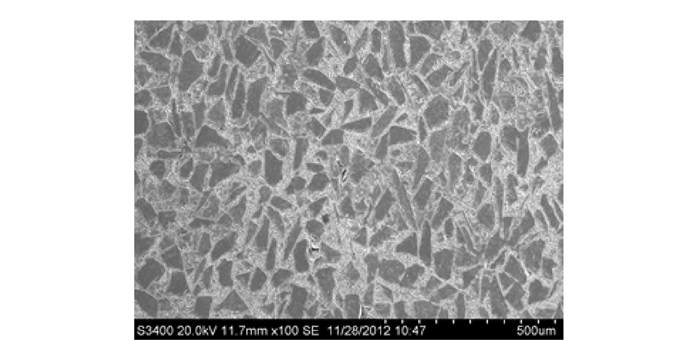
|
Fig. 1 Microstructure of SiCp/Al aluminum matrix composites |
1.2 Testing procedure
The system of laser welding consists of laser, five-axe CNC system, working head, shielding gas system and so on. The main technical parameters are shown in Table 1.
| Table 1 Main technical parameters of laser welding system |
The aluminum matrix composite was machined into the welding specimen of 20 mm × 15 mm × 2 mm by wire cutting. The specialized welding fixture is used to fix the quite thin weldments, as shown in Fig. 2. The aluminum and titanium were easily oxidized in air or during the electric discharge machining process, which had a great influence on the evaluation of laser welding. Hence, it was necessary to remove the surface oxidation layer by metallographical sand paper. Then the specimen was cleaned in acetone by ultrasonic technique. As the thickness of the titanium foil was just 0.5-1 mm and the size was quite small, it was difficult to polish entirely. Therefore, the mixture solution of HF and HNO3 (the ratio 15:15:70) was used to clean it.
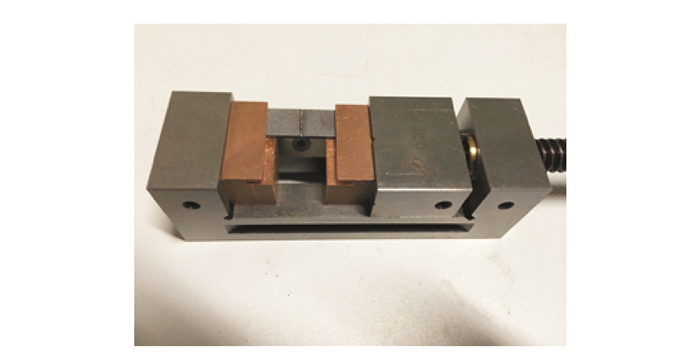
|
Fig. 2 Specialized welding fixture |
The specimen was welded by laser in flat position and required to keep horizontal. The flowing high pure argon was used to protect the top and back of the weld bead during the welding process. The main welding parameters were: laser power P, welding speed v and middle layer thickness d.
The morphology of the weld bead was observed by the scanning electron microscope (S-3400N). Before the tensile strength tests, the metallographic specimens were prepared by sand paper grinding and diamond paste polishing. The tensile strength test of welded joints was conducted on the CMT7504 electron universal testing machine which controlled by the microcomputer with the beam speed at 1.0 mm/min, the data acquisition point at 5.0 point/s and the temperature at 25 ℃.
The scheme of the micro-hardness test is shown in Fig. 3. The specimen was polished before the micro-hardness test, and then detected on the micro-hardness tester (HXS-1000AK). Then Vickers hardness profile across base material, heat affected zone and weld bead were measured and the distance between two points was just 0.05 mm. Moreover, the loading force was 1 N holding for 15 s.
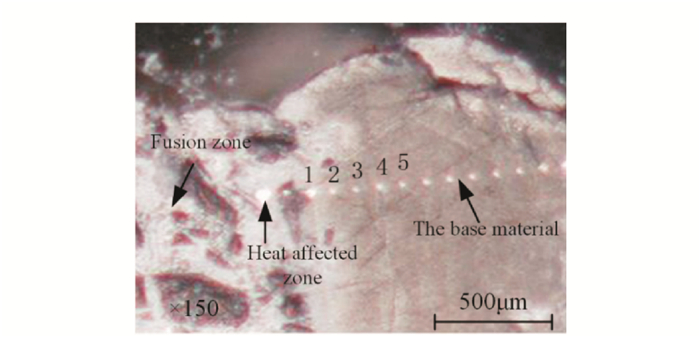
|
Fig. 3 Scheme of micro-hardness test |
2 Results and Discussion 2.1 Analysis of mechanical properties of the welded joints
It is a complex process of multiple factors to weld the high volume fraction SiCp/Al aluminum matrix composite by laser. The substrate melts again and previous strengthening state has been changed. Under a high temperature, the Si element and Al element have a great loss. The elements also segregate in the process of crystallization. Therefore, the distributions of strengthening phase, the shape and the amount which have a great influence on the mechanical properties of welded joints present a great variation.
An orthogonal test table made up of three factors and four horizontals is designed, as shown in Table 2.
| Table 2 Results of orthogonal test |
In order to study the effects of various factors, a method utilized to calculate and analyze results by variance is conducted in Table 3.SS, df, MS and F in the table denote square sum, degree of freedom, mean square and statistical magnitude, respectively.
| Table 3 Analysis of variance of orthogonal test |
We can obtain that F0.5(3, 3) equals 9.28 when we check out the table of critical value of F-test. The F value of the laser power and the middle layer thickness are all over 9.28. Therefore, the laser power and middle layer thickness have a huge influence on the welded joints of tensile strength. The F value of the welding speed is lower than 9.28, which means the influence on it is not obvious.
According to the analysis of variance, laser power has a significant influence on the tensile strength of welded joints of a high volume fraction SiCp/Al composite, and the middle layer thickness is followed. On the other hand, the welding speed has little effect on the tensile strength. The optimal combination of parameters is laser power at 1 200 W, welding speed at 1.5 m/min and middle layer thickness at 0.3 mm. In this case, the ultimate tensile strength of the welded joint is 118.4 MPa, which is equivalent to 51% of the tensile strength of base material. A higher tensile strength is obtained when compared with other combinations.
The effect of laser power on the tensile strength of welded joint is shown in Fig. 4. The laser power was 0.8, 1.0, 1.2, 1.5 kW, respectively. The middle layer was 0.3 mm, and the welding speed was 1.5 m/min. With the increasing laser power, it is obviously observed that the tensile strength demonstrates a sharp increase in the beginning. The tensile strength of the welded joint reaches its maximum value at the laser power of 1.2 kW. However, the laser power increases continuously while the tensile strength suffers a dramatically decrease. The tensile strength of the welded joint reduces to 54.35 MPa sharply at the laser power of 1.5 kW, which is still higher than that at the laser power of 0.8 kW. All in all, the laser power has a great influence on the tensile strength of welded joints.
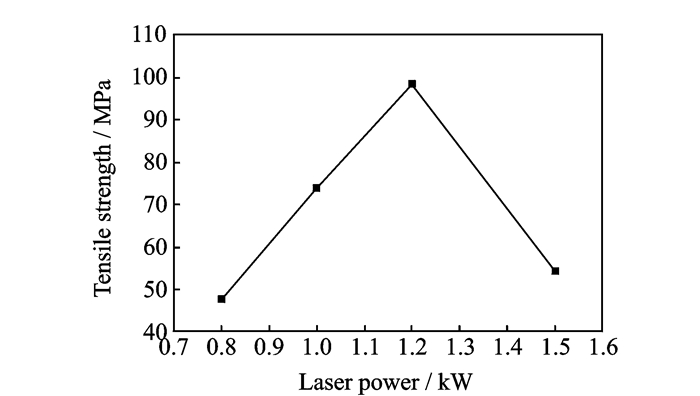
|
Fig. 4 Effect of laser power on the tensile strength of welded joint |
The molten pool has a large temperature gradient and diffusion occurs in the joined material during the laser welding process. The mutual diffusion between the base material and the middle layer material can be affected at a relative low laser power, which precludes the flow of molten pool. Then a chemical reaction happens between the base materials in the interface and it causes a lower tensile strength of welded joints. Meanwhile, the strengthening phase precipitates from the substrate. Hence, the tensile strength shows a decreasing trend.
The tensile strength of the welded joints with different middle layer thickness is shown in Fig. 5. The laser power is 1 200 W and the welding speed is 1.5 m/min. It can be seen that the tensile strength of the welded joints decreases with the increasing middle layer thickness. Thus the increasing middle layer thickness has a negative influence on the tensile strength. The maximum tensile strength is 86.62 MPa when the middle layer thickness is 0.3 mm.
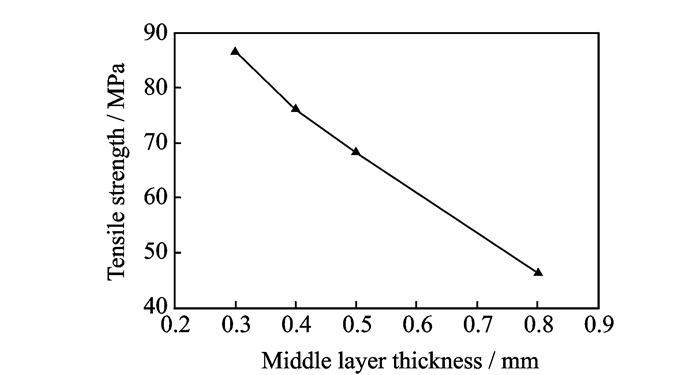
|
Fig. 5 Effect of middle layer thickness on tensile strength of the welded joint |
The SiC particles can be melted when the middle layer thickness is small, and then the Si and C elements flow into the molten pool in large quantities instead of accumulating at the interface. Therefore, the interfacial reaction layers gradually disappear and it means that the brittle compounds cannot be generated. As a result, the SiC particles cannot be melted and react with Ti elements located in the molten pool largely. The reaction is mainly concentrated in the interface, which can decrease the tensile strength of the welded joints.
2.2 Analysis of the micro-hardnessThe distribution of micro-hardness of the welded joints in different zones is shown in Fig. 6. It can be approximately divided into three areas: base material zone, heat-affected zone and weld bead zone.

|
Fig. 6 Distribution of micro-hardness in the welded joints |
As the distribution of the aluminum matrix and SiC particles is inhomogeneous in the base material zone, there is a huge difference between the aluminum matrix and SiC particles. Therefore, the micro-hardness in the base material zone fluctuates greatly. The micro-hardness is quite small when the pressure is completely exerted on the aluminum matrix. It changes greatly when the pressure absolutely imposes on the SiC particles and the micro-hardness is more than 2 500 HV. The indentation presents a slight deformation when partial pressure is exerted on the aluminum matrix and the other imposes on the SiC particles, and the micro-hardness is between the previous two values. The welding parameters have no influence on the micro-hardness of matrix when the three curves are combined, as shown in Fig. 6. The matrix cannot be influenced by heat that derives from laser as it is far away from the welding center.
The micro-hardness in the heat-affected zone decreases obviously and it is not stable, which always fluctuates between 500-1 000 HV. The SiC particles decompose and the molten aluminum substrate reacts with the metal solution in the molten pool that can form a new reactant in this area. It can be seen that the micro-hardness in the heat-affected zone is below 1 200 HV when the laser power is 1 500 W. In the meantime, the number of SiC particles that cannot dissolve sufficiently is quite small at the interface with a higher laser power, which can decrease the micro-hardness in this area.
It is obvious that the micro-hardness in the weld bead is improved to around 1 000 HV in Fig. 6, which is higher than the micro-hardness of TA2. The reason is that a new material of high micro-hardness generates in the molten pool. The distribution of the new material is homogeneous in the weld bead, which results in the substance made up of the mixture of various compounds. Additionally, the micro-hardness in the weld bead at the laser power of 1 500 W is lower than that at the laser power of 1 200 W when other parameters are guaranteed to be the same, but it is not obvious. The micro-hardness in the weld bead when the thickness of the additional material is 0.5 mm is lower than that with a thickness of 0.3 mm, as there is a poorer liquidity in the molten pool when the thickness is 0.5 mm. The insufficient reaction leads to a low ratio resultant generated by the "in-situ" reaction.
3 ConclusionsIn this paper, the high volume fraction SiCp/Al aluminum matrix composite has been successfully welded by laser. The welded joints are subjected to a number of orthogonal tensile examinations in order to study the factors which influence the tensile strength of the welded joints more. The optimum combination of parameters is attained. Then the micro-hardness in different areas is tested and analyzed. The main conclusions are summarized as follows:
(1) The results of the orthogonal experiments showed that the laser power and the middle layer thickness have a significant influence on the tensile strength of the welded joints. The optimal combination of parameters is the laser output power at 1 200 W, the middle layer thickness at 0.3 mm and the welding speed at 1.5 m/min. The maximum tensile strength is up to 118.4 MPa.
(2) The micro-hardness in the weld bead is improved, because a substance of high hardness is obtained by the reaction in the molten pool. The distribution of the new material is homogeneous in the weld bead, which ensures that the micro-hardness in this region is around 1 000 HV.
Acknowledgements
The work was supported by National Science and Technology Major Project of the Ministry of Science and Technology of China (No. 2014ZX04012014), the National Natural Science Foundation of China (No. 51505219), the Natural Science Foundation of Jiangsu Province (No. BK20150748), and the National Postdoctoral Foundation of China (No. 2018T110493).
| [1] |
BAHRAMI M, DEHGHANI K, BESHARATI GIVI M K. A novel approach to develop aluminum matrix nano-composite employing friction stir welding technique[J]. Materials & Design, 2014, 53(1): 217-225. |
| [2] |
DAI X Y, ZHANG H T, ZHANG H C, et al. Joining of magnesium and aluminum via arc-assisted ultrasonic seam welding with Sn/Zn composite interlayer[J]. Materials Letters, 2016, 178: 235-238. DOI:10.1016/j.matlet.2016.04.064 |
| [3] |
MENG C, CUI H C, LU F G, et al. Evolution behavior of TiB2 particles during laser welding on aluminum metal matrix composites reinforced with particles[J]. Transactions of Nonferrous Metals Society of China, 2013, 23(6): 1543-1548. DOI:10.1016/S1003-6326(13)62628-X |
| [4] |
PENG K, CUI H C, LU F G, et al. Mechanical properties and wear resistance of aluminum composite welded by electron beam[J]. Transactions of Nonferrous Metals Society of China, 2011, 21(9): 1925-1931. DOI:10.1016/S1003-6326(11)60951-5 |
| [5] |
SALIH O S, OU H, SUN W, et al. A review of friction stir welding of aluminium matrix composites[J]. Materials & Design, 2015, 86: 61-71. |
| [6] |
WANG H F, ZUO D W, WANG J L. Joining force of heterogeneous titanium alloy in linear friction welding process[J]. Transactions of Nanjing University of Aeronautics and Astronautics, 2016, 33(3): 370-374. |
| [7] |
ZHANG T. Resistance spot welding method for metal based fiber bragg grating sensors[J]. Transactions of Nanjing University of Aeronautics and Astronautics, 2015, 32(3): 289-296. |
| [8] |
NIU J T, PAN L X, WANG M Z, et al. Research on laser welding of aluminum matrix composite SiCw/6061[J]. Vacuum, 2006, 80(11): 1396-1399. |
| [9] |
SHI Y W, ZHONG F, LI X Y, et al. Effect of laser beam welding on tear toughness of a 1420 aluminum alloy thin sheet[J]. Materials Science and Engineering, 2007, 465(1): 153-159. |
| [10] |
WEI S T, HAO C Y, CHEN J C. Study of friction stir welding of a 1420 aluminum-lithium alloy[J]. Materials Science and Engineering, 2007, 452: 170-177. |
| [11] |
ZHANG D, ZHAO Z, GAO S, et al. Research on CO2 laser welding with filler wire of dissimilar high strength aluminum alloy 2024 and 7075[J]. Heythrop Journal, 2012, 49(3): 1-4. |
| [12] |
YAN J, GAO M, LI G, et al. Microstructure and mechanical properties of laser-MIG hybrid welding of 1420 Al-Li alloy[J]. The International Journal of Advanced Manufacturing Technology, 2013, 66(9/10/11/12): 1467-1473. |
| [13] |
DURMUS H, MERIC C. Weldability of Al99-SiC composites by CO2 laser welding[J]. Journal of Composite Materials, 2009, 43(13): 1435-1450. DOI:10.1177/0021998308105435 |
| [14] |
LIU H J, HU Y Y, ZHAO Y Q, et al. Microstructure and mechanical properties of friction stir welded AC4A +30 vol.% SiCp composite[J]. Materials & Design, 2015, 65(1): 395-400. |
| [15] |
OLABI A, ALSINANI F, ALABDULKARIM A, et al. Optimizing the CO2 laser welding process for dissimilar materials[J]. Optics and Lasers in Engineering, 2013, 51(7): 832-839. DOI:10.1016/j.optlaseng.2013.01.024 |
| [16] |
BENYOUNIS K, OLABI A, HASHMI M. Mechanical properties, weld bead and cost universal approach for CO2 laser welding process optimization[J]. International Journal of Computational Materials Science & Surface Engineering, 2009, 2(1): 99-109. |
 2018, Vol. 35
2018, Vol. 35


